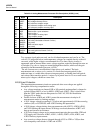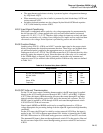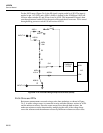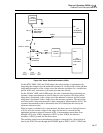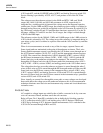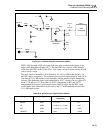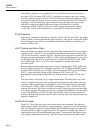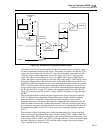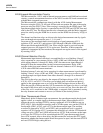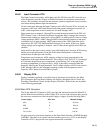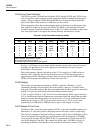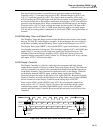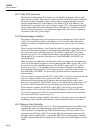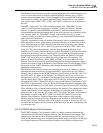
HYDRA
Service Manual
2A-32
2A-59. Inguard Microcontroller Circuitry
The Microcontroller, A3U9, with its internal program memory and RAM and associated
circuitry, controls measurement functions on the A/D Converter PCA and communicates
with the Main (outguard) processor.
The Microcontroller communicates directly with the A3U8 Analog Measurement
Processor using the CLK, CS, AR, and AS lines and can monitor the state of the analog
processor using the FC[0:7] lines. Filter zeroing is controlled by the ZERO signal. The
open thermocouple detect circuitry is controlled by the OTCCLK and OTCEN lines and
read by the OTC line. The Microcontroller also communicates with the Main (outguard)
processor serially using the IGDR line to receive and the IGDS line (driven by A3Q1) to
send.
The channel and function relays are driven to the desired measurement state by signals
sent out through microcontroller ports 1, 3, 4, 6, and 7.
On power up, the reset/break detect circuit made up of quad comparator A3U1,
capacitors A3C1 and A3C2, and resistors A3R1 through A3R6 and A3R8 resets the
Microcontroller through the RESET* line. When a break signal is received from the
outguard processor, the inguard A3U9 is again reset. Therefore, if Microcontroller
operation is interrupted by line transients, the outguard can regain control of the inguard
by resetting A3U9.
2A-60. Channel Selection Circuitry
Measurement input channel selection is accomplished by a set of latching 4-form-C
relays organized in a tree structure. Relays A3K5, A3K6, and A3K8 through A3K14
select among channels 1 through 20. Relay A3K7 disconnects rear input channels 1
through 20 from the measurement circuitry between measurements. Relay A3K3
switches in the front panel channel 0 or the rear channels. Inductors A3L1 through
A3L24 reduce EMI and current transients.
Selection between 2-wire and 4-wire operation for ohms measurements is performed by
latching 2-form-C relays (A3K1 and A3K2.) These relays also serve to select a voltage
or thermocouple rear input channel from either channels 1 through 10 or channels 11
through 20.
The coils for the relays are driven by the outputs of Darlington drivers A3U4, A3U5,
A3U10, A3U11, and A3U12. The relays are switched when a 6-millisecond pulse is
applied to the appropriate reset or set coil by the NPN Darlington drivers in these ICs.
When the port pin of Microcontroller A3U9 connected to the input of a driver is set high,
the output of the driver pulls one end of a relay set or reset coil low. Since the other end
of the relay coil is connected to the VDDR supply, a magnetic field is generated, causing
the relay armature and contacts to move to (or remain in) the desired position.
2A-61. Open Thermocouple Check
Immediately before a thermocouple measurement, the open thermocouple check circuit
applies a small, ac-coupled signal to the thermocouple input. Microcontroller A3U9
initiates the test by asserting OTCEN, causing comparator A3U14/A3R40 to turn on
JFET A3Q12. Next, the Microcontroller sends a 78-kHz square wave out the OTCCLK
line through A3R41, A3Q12, and A3C32 to the thermocouple input. The resulting
waveform is detected by A3U13 and A3CR2, and a proportional level is stored on
capacitor A3C30. Op amp A3U13 compares this detected level with the VTH threshold
voltage set up by A3R37 and A3R36 and stored on A3C29. If the resistance at the input
is too large, the VTH level will be exceeded and the OTC (open thermocouple check)
line will be asserted. After a short delay, the Microcontroller analyzes this OTC signal,
determines whether the thermocouple should be reported as open, and deasserts OTCEN
and sets OTCCLK high, ending the test.



